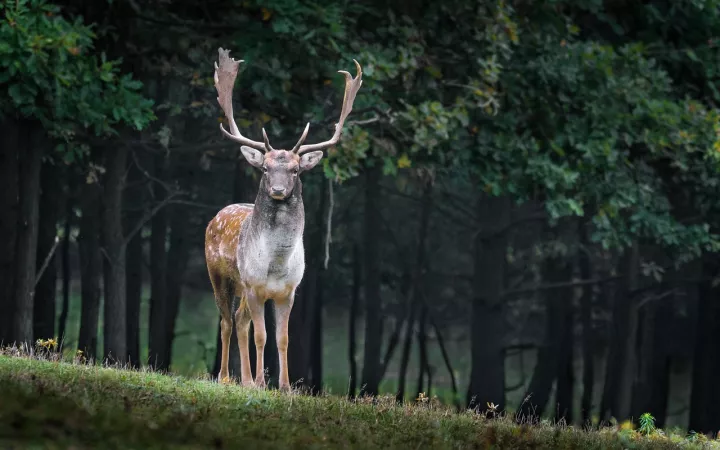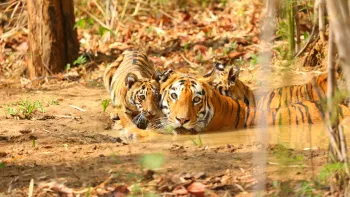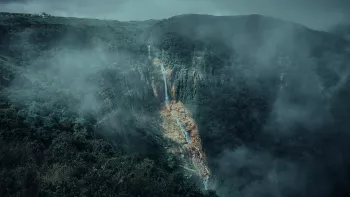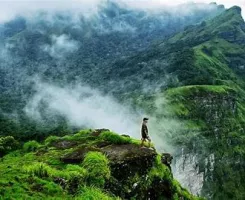
The Great Himalayan National Park
Duration
3 to 5 Days
3 to 5 Days
Best time to visit
Apr-Jun, Sep-Oct
Apr-Jun, Sep-Oct
Theme
Hill Station, Wildlife
Hill Station, Wildlife
The Great Himalayan National Park Travel Guide
Located in the majestic Himalayas, The Great Himalayan National Park is a UNESCO World Heritage Site in India. This park is renowned for its unique biodiversity, containing rare species of flora and fauna. The park's rugged terrain, snow-capped peaks, and lush forests make it a paradise for nature lovers and adventure enthusiasts. The rich cultural heritage of the local communities adds to the charm of this destination, offering visitors a glimpse into traditional mountain life.Top Attractions in The Great Himalayan National Park
- Exploring the diverse wildlife habitats
- Trekking through pristine mountain trails
- Witnessing the breathtaking views of the Himalayan peaks
- Interacting with local communities and experiencing their culture
- Camping under the starry skies
The Great Himalayan National Park is Famous for
Its unparalleled biodiversity and stunning Himalayan landscapes.Top Attractions in The Great Himalayan National Park
- Spotting rare Himalayan species like the snow leopard and blue sheep
- Visiting the Tirthan and Sainj Valleys for serene natural beauty
- Participating in eco-tourism activities to support conservation efforts
- Exploring ancient temples and traditional villages
- Enjoying adventure sports like river rafting and paragliding
What's Great about Travelling to The Great Himalayan National Park?
- Perfect for nature enthusiasts and wildlife lovers
- Offers a unique cultural experience
- Ideal for adventure seekers and trekkers
- Provides a serene and peaceful environment
What's Not So Great about Travelling to The Great Himalayan National Park?
- Not suitable for travelers looking for a luxurious vacation
- Limited accommodation options in remote areas
- Challenging terrain for those with mobility issues
- Weather conditions can be unpredictable
Travel Tips for The Great Himalayan National Park
- Obtain necessary permits for entry into the national park
- Pack warm clothing and sturdy footwear for trekking
- Stay hydrated and acclimatize to the high altitude
- Respect the local culture and traditions
Important The Great Himalayan National Park trip information
- Ideal Duration: 4-7 days to explore the park thoroughly
- Best Time to Visit: April to June and September to November for pleasant weather
- Nearby Airports and Railway Stations: The nearest airport is Bhuntar Airport, and the closest railway station is Joginder Nagar Railway Station
Per Person
15,000
*EXCLUDING APPLICABLE TAXES Per Person
18,000
*EXCLUDING APPLICABLE TAXES Per Person
16,500
*EXCLUDING APPLICABLE TAXES 5.0 Ratings
( 9 Reviews )
( 9 Reviews )
Per Person
56,000
*EXCLUDING APPLICABLE TAXES 5.0 Ratings
( 4 Reviews )
( 4 Reviews )
Per Person
70,000
*EXCLUDING APPLICABLE TAXES 5.0 Ratings
( 4 Reviews )
( 4 Reviews )
Per Person
34,990
*EXCLUDING APPLICABLE TAXES FAQ's on The Great Himalayan National Park
Q1: What is the best time to visit The Great Himalayan National Park?
The best time to visit The Great Himalayan National Park is during the months of April to June and September to November. These periods offer pleasant weather with clear skies, making it ideal for trekking and exploring the park's diverse flora and fauna. Avoid the monsoon season from July to August when heavy rainfall can make trails slippery and visibility poor. Winter months from December to February are chilly with chances of snowfall, limiting accessibility to certain areas of the park. Plan your visit according to the activities you wish to engage in and the wildlife you want to spot.
Q2: Do I need a visa to travel to The Great Himalayan National Park?
Foreign tourists visiting The Great Himalayan National Park need a valid Indian tourist visa. Ensure your passport is valid for at least six months beyond your intended stay. Nationals of certain countries may be eligible for e-Visa facilities, allowing for easier online application processes. Check with the Indian embassy or consulate in your home country for specific visa requirements and any exceptions. It is advisable to apply for your visa well in advance of your travel dates to allow for processing time.
Q3: What are the must-visit attractions in The Great Himalayan National Park?
The Great Himalayan National Park offers a range of attractions for nature lovers and adventure enthusiasts. Some of the must-visit places include the Tirthan Valley, known for its scenic beauty and trout fishing opportunities. The Sainj Valley is another highlight with its lush forests and diverse wildlife. Trekking routes like the Shilt Hut and Rolla are popular for experiencing the park's biodiversity up close. The Serolsar Lake, nestled amidst pine forests, is a serene spot for picnics and photography. Wildlife enthusiasts should explore the park's rich fauna, including Himalayan tahr, musk deer, and various bird species.
Q4: Is The Great Himalayan National Park a safe place to travel?
The Great Himalayan National Park is a relatively safe destination for travelers. However, it is essential to be cautious while trekking or exploring remote areas within the park. Follow designated trails, travel with a guide if needed, and inform authorities about your plans. The park's terrain can be challenging, so ensure you are physically prepared for outdoor activities. Avoid venturing out alone, especially in secluded areas, and be mindful of wildlife encounters. As with any outdoor excursion, it is advisable to carry essential supplies, stay updated on weather conditions, and adhere to park rules for a safe and enjoyable experience.
Q5: What is the local currency in The Great Himalayan National Park and can I use credit cards?
The local currency in The Great Himalayan National Park is the Indian Rupee (INR). While credit cards are accepted at some hotels, restaurants, and larger establishments in nearby towns like Kullu and Manali, it is advisable to carry sufficient cash when visiting remote areas within the park. ATMs may not be readily available in all locations, so plan accordingly. Inform your bank about your travel plans to ensure smooth card transactions and inquire about any foreign transaction fees. Money exchange services are available in major cities for currency conversion if needed.
Q6: What is the local cuisine like in The Great Himalayan National Park?
The local cuisine in The Great Himalayan National Park reflects the traditional flavors of Himachal Pradesh with influences from Tibetan and North Indian culinary traditions. Popular dishes include Sidu (steamed bread), Dham (a multi-course meal served during festivals), and Thukpa (noodle soup). Try local specialties like Chha Gosht (lamb curry), Babru (black gram stuffed bread), and Mittha (sweet rice dish) for a taste of regional delicacies. Vegetarians can enjoy dishes like Madra (chickpea curry) and Chana Madra (chickpeas in yogurt gravy). Don't miss sampling Himachali apples, apricots, and local teas like Kahwa. Be mindful of food hygiene practices, especially when dining at local eateries, and respect dietary preferences of the region.
Q7: What transportation options are available in The Great Himalayan National Park?
Transportation options in The Great Himalayan National Park vary depending on the specific location within the park and nearby towns. Public buses and shared taxis are common modes of travel between major towns like Aut, Banjar, and Gushaini. Private taxis and rental cars are available for more flexibility in exploring the park's diverse areas. Trekking and walking are popular for accessing remote trails and viewpoints within the park. Ensure you have a reliable map or guidebook for navigation, especially in less frequented areas. Consider the terrain and weather conditions when choosing your mode of transportation, and be prepared for occasional road closures or delays due to maintenance work or inclement weather.
Q8: Are there any cultural norms or etiquette I should be aware of when visiting The Great Himalayan National Park?
When visiting The Great Himalayan National Park, it is important to respect the local customs and traditions of the region. Dress modestly, especially when visiting religious sites or interacting with local communities. Remove your shoes before entering temples or homes and seek permission before taking photographs of individuals. Greet locals with a polite 'Namaste' and show appreciation for their hospitality. Avoid public displays of affection and be mindful of your language and behavior in public spaces. Participate in eco-friendly practices by avoiding littering and supporting sustainable tourism initiatives. Learn about the cultural heritage of the area through interactions with residents, attending local festivals, and trying traditional arts and crafts. Embrace the unique cultural diversity of the Himalayan region with an open and respectful attitude.
Q9: I am a travel agent. How can I buy travel leads of The Great Himalayan National Park?
Register yourself as a travel agent at agents.tripclap.com and then you can buy travel leads to The Great Himalayan National Park once your account is approved. For more details contact our support team at +91-8069186564 or support@tripclap.com






